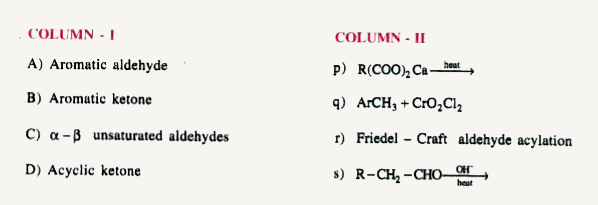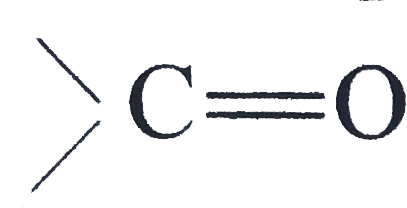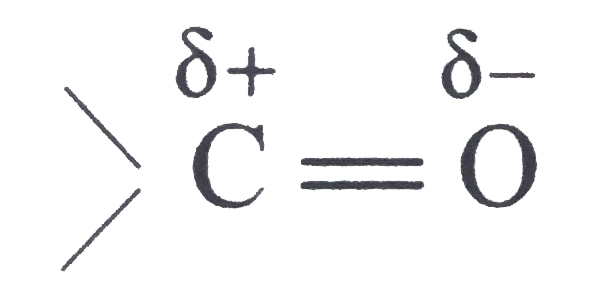Aldehydes and ketons are susceptible to nuclephlic addition because carbonylgroup 
Polar (due to electronegativeity difference between carbon and oxygen 
positive charge on carbonyl compound towards nucleophilic . this addition is catalysed by acid . REactivity of carbonyl compound towards nuclephilic addotion increase with increase in teh electron deficiency at carbonyl carbon Thus (-I.E ) groups increase while (+I.E ) groups decreases the reactivity of carbonyl compound .
Carbonyl compounds show nucleophilic addition with : Solution in Telugu
HCN
NaHSO3
(CH3OH)
all of these
The correct Answer is:D
R−O∣∣C−HHCN−−→R−OH∣C∣CN−H ( Nucleophilic addition ) R−O∣∣C−HNaHSO3−−−−−→R−O⊕Na⊕∣C∣HSO3−H ( nucleophilic addition )
R−O∣∣C−HCH3OH−−−−→R−OH∣C∣OCH3−H ( nucleophilic addition)
Topper's Solved these Questions
- ALDEHYDES AND KETONESBOOK - AAKASH SERIESCHAPTER - ALDEHYDES AND KETONESEXERCISE - LEVEL-II LECTURE SHEET (EXERCISE-IV)
8 Videos
- ALDEHYDES AND KETONESBOOK - AAKASH SERIESCHAPTER - ALDEHYDES AND KETONESEXERCISE - LEVEL-II LECTURE SHEET (EXERCISE-V)
16 Videos
- ALDEHYDES AND KETONESBOOK - AAKASH SERIESCHAPTER - ALDEHYDES AND KETONESEXERCISE - LEVEL-II LECTURE SHEET (EXERCISE-II)
28 Videos
- ALCOHOLS, PHENOLS AND ETHERSBOOK - AAKASH SERIESCHAPTER - ALCOHOLS, PHENOLS AND ETHERSEXERCISE - ETHERS (OBJECTIVE EXERCISE-4)
50 Videos
- ALKYL AND ARYL HALIDESBOOK - AAKASH SERIESCHAPTER - ALKYL AND ARYL HALIDESEXERCISE - OBJECTIVE EXERCISE - 4 (ASSERTION (A) & REASON (R) TYPE QUESTIONS)
19 Videos
Similar Questions
Complete the following reaction

View SolutionHow many functional isomers are possible for the formula C4H8O?
View SolutionWhich of the following give N- subtituted amide from ketoxime ?
View Solution(A): Alcoholic fermentation involves conversion of sugar into ethanol by the action of yeast.
(R): Fermentation involves the liberation of CO2 gas.
View Solution(A) Towards SN2 reaction, order of reactivity is CH3Br>CH3CH2Br>(CH3)2CHBr>(CH3)3CBr.
(R) Greater the stability of carbocation, greater will be its ease of formation from alkyl halide and faster will be the rate of SN1 reaction.
View SolutionAldehyde and ketones are specially susceptible susceptible to nucleophile addition because carbonyl group (due to electronegatvity different between carbon and oxygen). Positive charge on carbon makes it reactive towards the nucleophile. This addition is catalysed by acid. Reactivity of carbonyl compound towards nucleophilic addition increases in the electron deficience at carbonyl carbon. Thus, (-I.E.) group increase while (+I.E.) groups decrease the reactivity of carbonyl compound Which of the following is most reactve to give nucleophilic addition?
View SolutionAldehyde and ketones are specially susceptible susceptible to nucleophile addition because carbonyl group (due to electronegatvity different between carbon and oxygen). Positive charge on carbon makes it reactive towards the nucleophile. This addition is catalysed by acid. Reactivity of carbonyl compound towards nucleophilic addition increases in the electron deficience at carbonyl carbon. Thus, (-I.E.) group increase while (+I.E.) groups decrease the reactivity of carbonyl compound Carbonyl compounds show nucleophilic addition with:
View SolutionAldehyde and ketones are specially susceptible susceptible to nucleophile addition because carbonyl group (due to electronegatvity different between carbon and oxygen). Positive charge on carbon makes it reactive towards the nucleophile. This addition is catalysed by acid. Reactivity of carbonyl compound towards nucleophilic addition increases in the electron deficience at carbonyl carbon. Thus, (-I.E.) group increase while (+I.E.) groups decrease the reactivity of carbonyl compound Which among the following carbonyl compounds is most polar?
View SolutionAldehyde and ketones are specially susceptible susceptible to nucleophile addition because carbonyl group (due to electronegatvity different between carbon and oxygen). Positive charge on carbon makes it reactive towards the nucleophile. This addition is catalysed by acid. Reactivity of carbonyl compound towards nucleophilic addition increases in the electron deficience at carbonyl carbon. Thus, (-I.E.) group increase while (+I.E.) groups decrease the reactivity of carbonyl compound Select the least reactive carbonyl compound for nucleophilic addition:
View SolutionAldehyde and ketones are specially susceptible susceptible to nucleophile addition because carbonyl group (due to electronegatvity different between carbon and oxygen). Positive charge on carbon makes it reactive towards the nucleophile. This addition is catalysed by acid. Reactivity of carbonyl compound towards nucleophilic addition increases in the electron deficience at carbonyl carbon. Thus, (-I.E.) group increase while (+I.E.) groups decrease the reactivity of carbonyl compound
View SolutionAldehydes and ketones ar specially susecptible to nucleophilic addition because carbonyl group is polar (due to electronegativity difference between carbon and oxygen) Positive charge on carbon makes it reactive towards the nucleophili. This addition is catalysed by acid. Reactivity of carbonyl compound towards nucleophilic addition increases with increases in the electron deficiency at carbonyl carbon. Thus, (-I.E.)groups increase while (+I.E.) groups decrease the reactivity of carbonyl compound. Which among the following is most reactive to give nucleophilic addtion ?
View SolutionAldehydes and ketones ar specially susecptible to nucleophilic addition because carbonyl group is polar (due to electronegativity difference between carbon and oxygen) Positive charge on carbon makes it reactive towards the nucleophili. This addition is catalysed by acid. Reactivity of carbonyl compound towards nucleophilic addition increases with increases in the electron deficiency at carbonyl carbon. Thus, (-I.E.)groups increase while (+I.E.) groups decrease the reactivity of carbonyl compound. Carbonyl compounds show nucleophilic addition with :
View SolutionAldehydes and ketones ar specially susecptible to nucleophilic addition because carbonyl group is polar (due to electronegativity difference between carbon and oxygen) Positive charge on carbon makes it reactive towards the nucleophili. This addition is catalysed by acid. Reactivity of carbonyl compound towards nucleophilic addition increases with increases in the electron deficiency at carbonyl carbon. Thus, (-I.E.)groups increase while (+I.E.) groups decrease the reactivity of carbonyl compound. Which among teh following carbonyl compounds is most pola?
View SolutionAldehydes and ketones ar specially susecptible to nucleophilic addition because carbonyl group is polar (due to electronegativity difference between carbon and oxygen) Positive charge on carbon makes it reactive towards the nucleophili. This addition is catalysed by acid. Reactivity of carbonyl compound towards nucleophilic addition increases with increases in the electron deficiency at carbonyl carbon. Thus, (-I.E.)groups increase while (+I.E.) groups decrease the reactivity of carbonyl compound. Select the least reactive carbonyl compound for nucleophilic addition :
View SolutionAldehydes and ketones ar specially susecptible to nucleophilic addition because carbonyl group
 is polar (due to electronegativity difference between carbon and oxygen)
is polar (due to electronegativity difference between carbon and oxygen)

Positive charge on carbon makes it reactive towards the nucleophili. This addition is catalysed by acid.
Reactivity of carbonyl compound towards nucleophilic addition increases with increases in the electron deficiency at carbonyl carbon. Thus, (-I.E.)groups increase while (+I.E.) groups decrease the reactivity of carbonyl compound.
Which among the following isomeric compounds is most reactive?
View Solution
